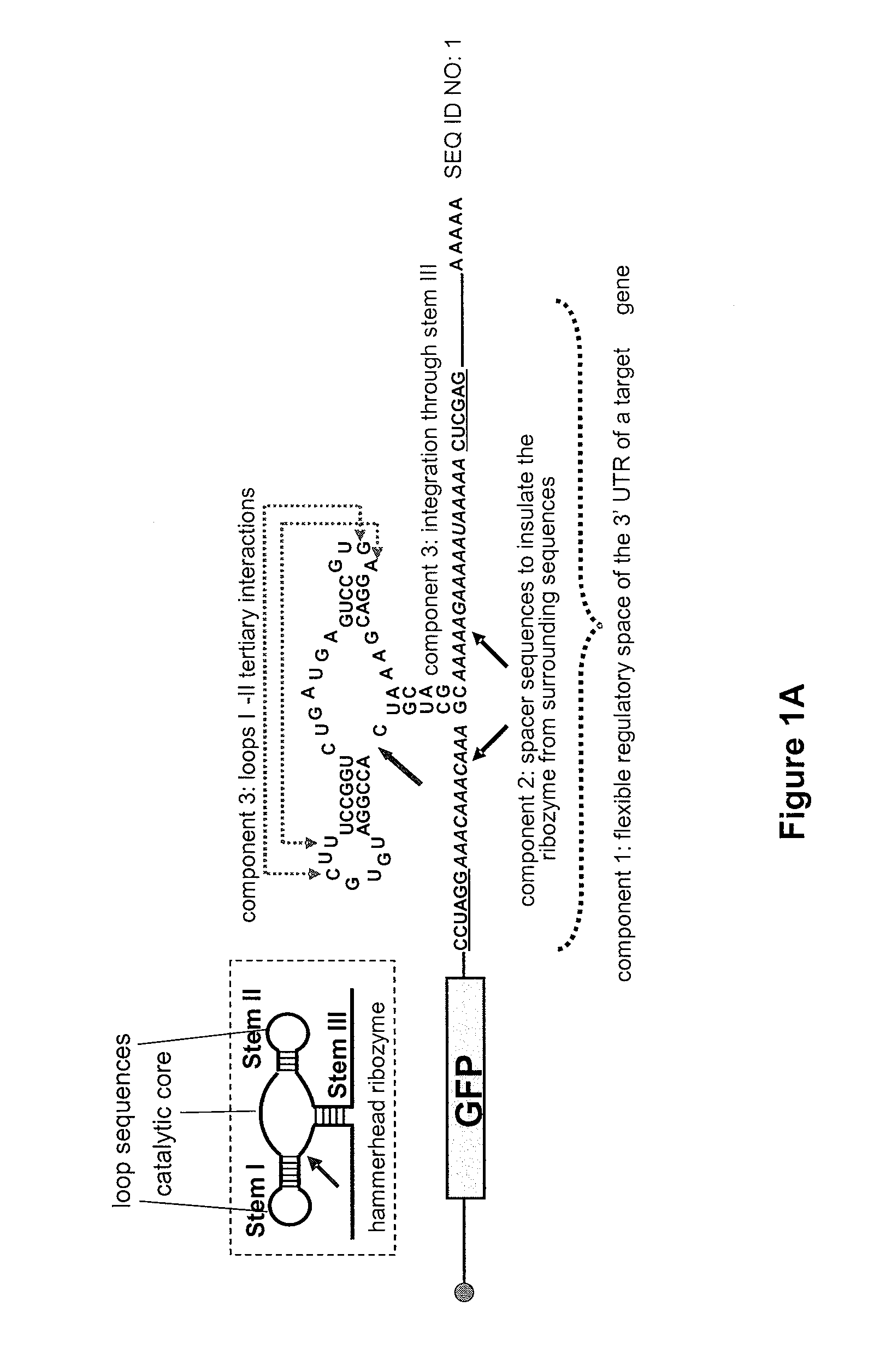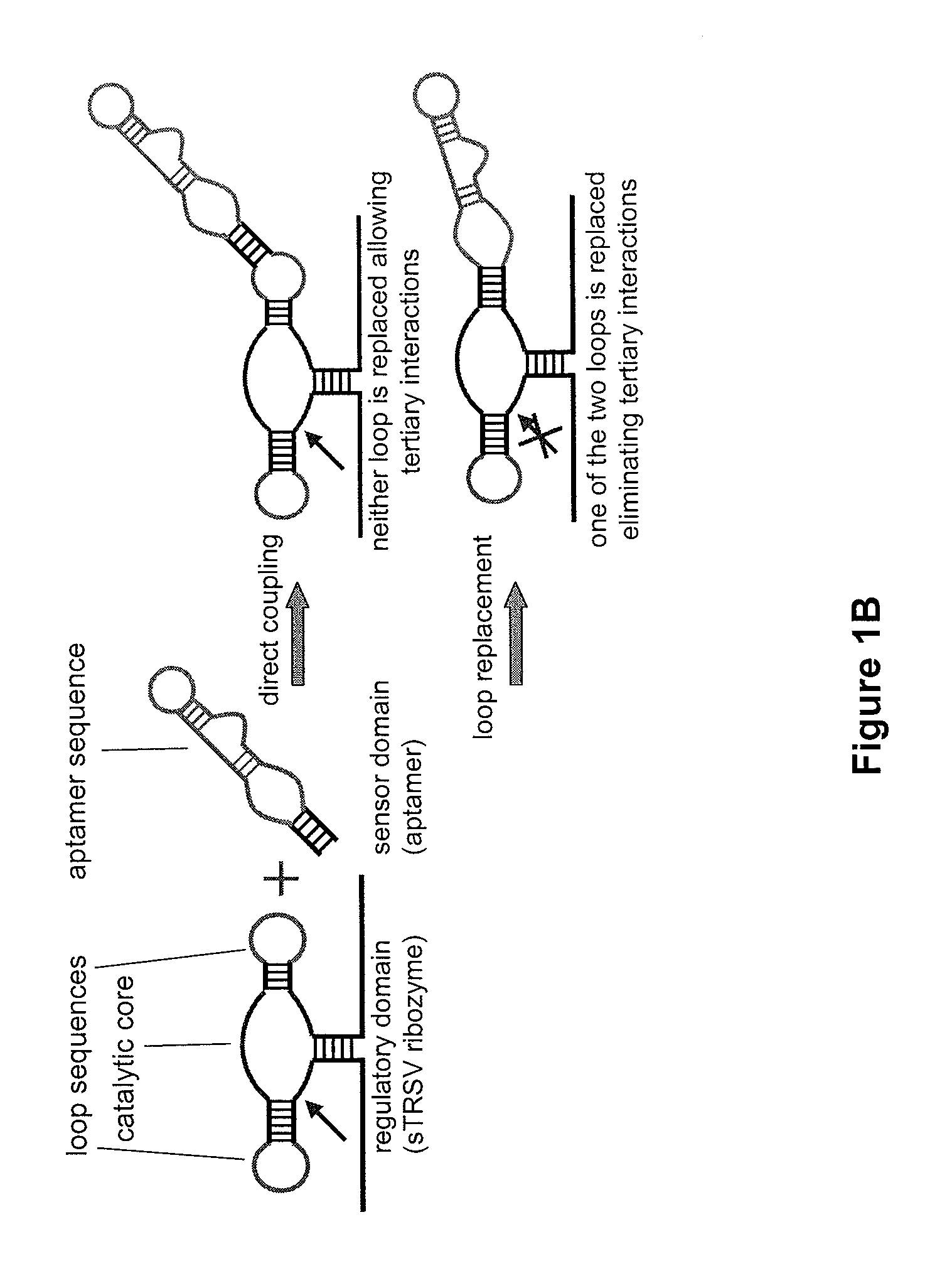Modular aptamer-regulated ribozymes
a ribozyme and module technology, applied in the field of module aptamer-regulated ribozymes, can solve the problems of inaccessible cellular information content, many of the molecular inputs to these systems are not ideal for broad implementation, and the size of the loop is altered, so as to alter the ability of ribozyme, alter the size of the loop, and alter the ability of the ribozyme
- Summary
- Abstract
- Description
- Claims
- Application Information
AI Technical Summary
Benefits of technology
Problems solved by technology
Method used
Image
Examples
example 1
Generation of Modular and Scalable Aptamer-Regulated Cis-Ribozymes
[0132]To satisfy the engineering design principle of scalability (DP1) we chose RNA aptamers (11), nucleic acid ligand-binding molecules, as the sensing platform for the universal control system. Our choice of sensing platform was driven by the proven versatility of RNA aptamers. Standard in vitro selection strategies or SELEX (12, 13) have been used to generate RNA aptamers de novo to a wide variety of ligands, including small molecules, peptides, and proteins (14). In addition, the specificity and affinity of an aptamer can be tuned through the selection process to meet the specific performance requirements of a given application. The continued selection of new aptamers to appropriate cellular molecules that function under in vivo conditions will enable these elements to be implemented as sensors in RNA-based control systems.
[0133]To satisfy the engineering design principle of portability (DP2) we chose the hammerhe...
example 2
Supplemental Data for Aptamer-Regulated Cis-Ribozymes
Ribozyme Control Constructs for Loop Sequence Coupling and Stem Integration Controls
[0181]To establish and make useful our design strategy we constructed and characterized a series of ribozyme controls. We characterized the regulatory activity of our ribozyme constructs within a modular ribozyme characterization system in the eukaryotic model organism Saccharomyces cerevisiae (FIG. 1A). First, an inactive ribozyme control (sTRSV Contl) was constructed to adopt the same structural motif as sTRSV (FIG. 1A), while carrying a scrambled catalytic core sequence (FIG. 7A). Second, a synthetic sTRSV ribozyme (hhRz I) that contains closed loops in stems II and III and is embedded through stem I was constructed as a stem integration control (FIG. 7A). Finally, we constructed four loop sequence controls. In one set, stem loops I and II (L1R and L2R, respectively) were replaced by the theophylline aptamer TCT8-4 (S1) (FIG. 7B), and in another...
example 3
The Ribozyme Switch Platform Exhibits Portability Across Diverse Cellular Systems
[0201]The cleavage activity of the hammerhead ribozyme is independent of cell type, as it does not require cell-specific machinery to assist its self-cleavage, thereby making this regulatory element universally applicable to different cellular systems. Therefore, in order to demonstrate that the constructed ribozyme-based switch platform retains ligand-regulated gene control activity in a cellular system different than S. cerevisiae, we implemented the strand displacement-based ON switches (L2bulge1, L2bulge8, and L2bulge9) in mammalian T cells (CTLL-2). Similar to the implementation in yeast, the ribozyme switch constructs were built by placing these switches downstream (in the 3′ UTR, surrounded by spacer / insulater sequences) of a target fusion gene encoding enhanced green fluorescence protein (EGFP) and interleukin-2 (IL-2). An increase in target gene expression levels was observed in the presence of...
PUM
| Property | Measurement | Unit |
|---|---|---|
| optical density | aaaaa | aaaaa |
| emission wavelength | aaaaa | aaaaa |
| excitation wavelength | aaaaa | aaaaa |
Abstract
Description
Claims
Application Information
 Login to View More
Login to View More - R&D
- Intellectual Property
- Life Sciences
- Materials
- Tech Scout
- Unparalleled Data Quality
- Higher Quality Content
- 60% Fewer Hallucinations
Browse by: Latest US Patents, China's latest patents, Technical Efficacy Thesaurus, Application Domain, Technology Topic, Popular Technical Reports.
© 2025 PatSnap. All rights reserved.Legal|Privacy policy|Modern Slavery Act Transparency Statement|Sitemap|About US| Contact US: help@patsnap.com



